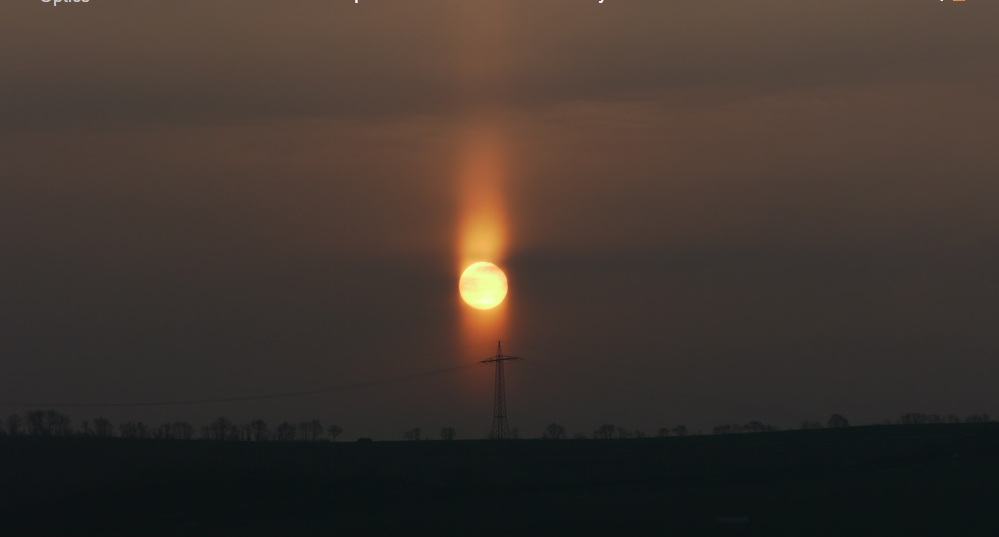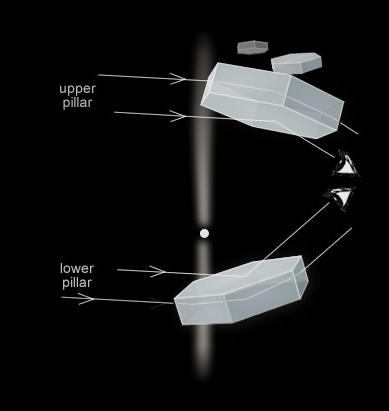Morning Pillars at Trier
Morning Pillars at Trier: A Captivating Atmospheric Phenomenon
The mesmerizing sight of morning pillars brushing the early morning sun over Trier, Germany, never fails to captivate observers. These ethereal pillars, which appear as vertical beams of light extending above and below the sun, are a stunning display of atmospheric optics. While the image above showcases near-perfect plate crystals, it is important to note that the actual crystals responsible for creating morning pillars are often large and somewhat irregular in shape, lying somewhere between perfect crystals and delicate snowflakes.
Morning pillars are formed when sunlight is reflected externally and internally from the large basal faces of plate crystals. These crystals, although not as symmetrical as those depicted in the image, possess the unique ability to scatter light and create this awe-inspiring phenomenon. The interplay between the angle of the sunlight and the orientation of the crystals determines the height and shape of the pillars, resulting in a truly remarkable display.
The occurrence of morning pillars is not limited to specific locations; however, Trier, with its picturesque landscapes and historical charm, provides a beautiful backdrop for witnessing this captivating atmospheric event. As the early morning sun rises over Trier, its rays interact with the crystal-laden atmosphere, giving birth to these radiant columns of light. The serene beauty of Trier enhances the overall experience, making it an ideal destination for nature enthusiasts and photographers seeking to capture this enchanting spectacle.
To fully appreciate the intricacies of morning pillars at Trier, it is essential to understand the science behind their formation. Plate crystals, which serve as the building blocks for these pillars, are irregularly shaped ice particles suspended in the atmosphere. These crystals can range in size and exhibit various degrees of imperfections, giving each pillar its unique character. As sunlight passes through these crystals, it undergoes a process called refraction, causing the light to change direction and split into its constituent colors. This dispersion of light adds a vibrant and colorful element to the pillars, heightening their visual appeal.
The alignment of the plate crystals is crucial in determining the height and intensity of the morning pillars. When these crystals are oriented horizontally, they act as miniature mirrors, reflecting sunlight vertically and creating the illusion of pillars extending above and below the sun. The angle at which the sunlight interacts with the crystals plays a vital role in shaping the pillars. As the sun rises higher in the sky, the pillars gradually diminish, eventually fading away as the angle between the sunlight and crystals becomes less favorable for reflection.
While morning pillars at Trier are undoubtedly a sight to behold, it is important to note that they are not exclusive to this location. Similar atmospheric phenomena can be observed in various regions around the world, each offering its own unique blend of natural beauty and atmospheric conditions. From snow-covered landscapes to urban cityscapes, morning pillars can grace any backdrop, creating moments of wonder and amazement.
In conclusion, morning pillars at Trier exemplify the magic and grandeur of atmospheric optics. The interplay between sunlight and irregularly shaped plate crystals creates a breathtaking display of vertical beams of light extending above and below the sun. While Trier provides a picturesque setting for witnessing this phenomenon, it is not limited to this location alone. Nature enthusiasts and photographers worldwide can revel in the enchantment of morning pillars, as they grace various landscapes with their ethereal presence. So, keep your eyes to the sky, for you never know when you might witness this extraordinary spectacle that nature has to offer.

Morning Pillars ~ Upper and lower pillars brush the early morning sun over Trier, Germany. Captured by Eva Seidenfaden (Paraselene Optics site) on February 10, 2010. Panasonic Lumix GH1 at 95mm 1/5000s. ©Eva Seidenfaden, shown with permission.
Sunlight reflected externally, and internally, from the large basal faces of plate crystal produce pillars. The crystals are unlikely, however, to be the perfect ones pictured at right. Large wobbly crystals somewaht intermediate between those and snowflakes are often responsible.

Note: this article has been automatically converted from the old site and may not appear as intended. You can find the original article here.
Reference Atmospheric Optics
If you use any of the definitions, information, or data presented on Atmospheric Optics, please copy the link or reference below to properly credit us as the reference source. Thank you!
-
<a href="https://atoptics.co.uk/blog/morning-pillars-at-trier/">Morning Pillars at Trier</a>
-
"Morning Pillars at Trier". Atmospheric Optics. Accessed on April 20, 2024. https://atoptics.co.uk/blog/morning-pillars-at-trier/.
-
"Morning Pillars at Trier". Atmospheric Optics, https://atoptics.co.uk/blog/morning-pillars-at-trier/. Accessed 20 April, 2024
-
Morning Pillars at Trier. Atmospheric Optics. Retrieved from https://atoptics.co.uk/blog/morning-pillars-at-trier/.